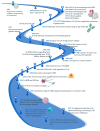A Comprehensive Review of Fc Gamma Receptors and Their Role in Systemic Lupus Erythematosus
- PMID: 40076476
- PMCID: PMC11899777
- DOI: 10.3390/ijms26051851
A Comprehensive Review of Fc Gamma Receptors and Their Role in Systemic Lupus Erythematosus
Abstract
Receptors for the immunoglobulin G constant fraction (FcγRs) are widely expressed in cells of the immune system. Complement-independent phagocytosis prompted FcγR research to show that the engagement of IgG immune complexes with FcγRs triggers a variety of cell host immune responses, such as phagocytosis, antibody-dependent cell cytotoxicity, and NETosis, among others. However, variants of these receptors have been implicated in the development of and susceptibility to autoimmune diseases such as systemic lupus erythematosus. Currently, the knowledge of FcγR variants is a required field of antibody therapeutics, which includes the engineering of recombinant soluble human Fc gamma receptors, enhancing the inhibitory and blocking the activating FcγRs function, vaccines, and organ transplantation. Importantly, recent interest in FcγRs is the antibody-dependent enhancement (ADE), a mechanism by which the pathogenesis of certain viral infections is enhanced. ADEs may be responsible for the severity of the SARS-CoV-2 infection. Therefore, FcγRs have become a current research topic. Therefore, this review briefly describes some of the historical knowledge about the FcγR type I family in humans, including the structure, affinity, and mechanism of ligand binding, FcγRs in diseases such as systemic lupus erythematosus (SLE), and the potential therapeutic approaches related to these receptors in SLE.
Keywords: Fc gamma receptor; Fc?R; FcgR; FcgRIIIa; FcgRIIIb; FcgRIIa; SLE; autoimmune disease; autoimmunity; phagocytosis.
Conflict of interest statement
The authors declare no conflict of interest.
Figures




References
Publication types
MeSH terms
Substances
LinkOut - more resources
Full Text Sources
Medical
Miscellaneous

